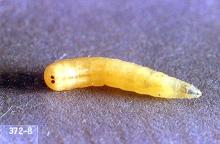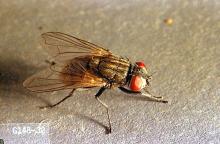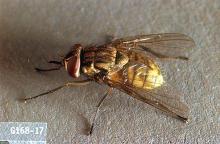Cecid flies (Mycophila speyeri, Heteropeza pygmaea)
House fly (Musca domestica)
Phorid fly (Megaselia halterata)
Sciarid fly (Lycoriella mali)
Stable fly (Stomoxys calcitrans)
Management-cultural control
Cultural control, including sanitation, composting and pasteurization is the basis for successful mushroom culture. Cultural practices that can reduce pest fly populations include exclusion, sanitation (washing and sanitizing), shortening crop cycles and post-harvest steam cleaning. In compost wharves, fly populations can be reduced by promoting drainage and reducing of standing. Fly exclusion is critical: rooms should be sealed and properly screened to exclude breeding flies. Attention should be paid to doors, fans, ceiling joints, drains and ductwork. Lights and traps near doorways may be of value. Equipment and personnel should not move from older culture rooms (where infestations tend to exist) to newer, uninfested rooms. Limit the amount of time that doors are left open.
Management-biological control
Pest Biology and Crop Damage The morphology of most mushroom flies have four distinct life stages: eggs, larvae, pupae and adult. The major insect pest of mushrooms is the sciarid fly, a small black insect about 0.25 inch in length, with long antennae and gray wings folded over the back. Sciarid larvae attack compost, spawn, mycelia, pins, and mushroom stems and caps. Phorid flies are very small, 0.125 inch long (half the size of a fruit fly), with a humpback appearance and very small antennae. They are stockier than sciarids and are very active, running and hopping erratically. These flies feed on mycelia, depressing crop yields. Both sciarid and phorid adults carry disease organisms into the crop. Cecid species are rarely seen as adult flies, because under the warmth of mushroom culture larvae become "mother larvae" giving birth directly to 10 to 30 daughter larvae. Cecids feed on the mushroom stems or gills, reducing marketable yield. Stable fly and house fly are common pests in compost wharves.
A number of entomopathogenic nematodes are used successfully against mushroom flies because of the moist organic growing media. Steinernema feltiae is effective against sciarids. Howardula hussey occurs naturally in phorid populations. Bacillus thuringiensis israelensis (Bti) is a bacterium used widely in biocontrol of flies: Bti appears to be more effective against earlier instar sciarid larvae.
In compost wharves, augmentation of naturally occurring pteromalid wasps is used for control of house fly and stable fly: Spalangia endius, Muscidifurax raptor, M. zaraptor, and M. raptorellus are commercially available.
Management-chemical control
Note: Some labels specify Agaricus bisporus (the button mushroom) as the intended crop. In such cases, the product is registered legally for use only on Agaricus mushrooms.
|
Mushroom sites, pests, and controls |
||
|---|---|---|
|
Site |
Controls -follow label rates- |
Comments and cautions |
|
Empty mushroom house |
azadirachtin DDVP (empty house only) MGK 264 (empty house only) pyrethrin + PBO |
|
|
Filling |
azadirachtin geranium oil; peppermint; rosemary |
|
|
Spawning |
azadirachtin Bacilllus thuringiensis sp. israelensis Beauveria bassiana GHA cyromazine1 geranium oil; peppermint; rosemary Isaria fumosorosea |
To be effective, pesticides must be incorporated thoroughly into the compost. It is important that end sections and sides be treated completely. |
|
Casing |
azadirachtin Bacilllus thuringiensis ssp. israelensis Beauveria bassiana GHA geranium oil; peppermint; rosemary Isaria fumosorosea S-methoprene |
Drench onto casing layer with sufficient water for good penetration. |
|
Growth-Pinning |
azadirachtin malathion pyrethrin + PBO permethrin + PBO |
Adult fly control. |
|
Picking |
pyrethrin + PBO (aerosol) pyrethrin (aerosol) |
Use effectively to knock down adult flies prior to pickers entering rooms. |
|
1Cyromazine-treated spent compost cannot be used to grow food crops. |
||
|
Pesticides registered for use in mushroom houses and/or on mushroom crops |
||||
|---|---|---|---|---|
|
Common name |
Brand names |
IRAC Class1 |
Signal Word Toxicity class |
Uses and precautions |
|
azadirachtin (neem) |
AzaGuard, Azatin O (WA only), Azasol, Azasol WSP, Debug Tres, Ecozin Plus 1.2ME |
BP |
Caution/IV; very low |
Sciarid and phorid fly control incorporated into compost or casing soil; disrupts fly development. Some formulations are OMRI-listed for organic use. |
|
Bacilllus thuringiensis ssp. israelensis |
Gnatrol DG |
MI |
Caution/IV; very low |
Sciarid and phorid fly control incorporated into compost or casing soil; disrupts fly development at the larval stage. |
|
Beauveria bassiana GHA; Pyrethrins |
Botanigard MAXX (WA only) |
MI |
Warning/III; low |
Sciarid and phorid fly control incorporated into compost or casing soil; fungus infects fly larvae. Some formulations are OMRI-listed for organic use. |
|
cyromazine |
Armor IGR, Aegis |
IGR |
Caution/III; low |
Sciarid fly control incorporated into compost; disrupts fly development. Spent, treated compost cannot be used to grow food crops. |
|
DDVP (dichlorovos) |
Nuvan Fog 5% |
OP |
Danger Poison/I; high |
Phorid flies. Empty houses, and no less than 10 days before mushrooms in beds |
|
geranium oil; peppermint; rosemary |
Brandt Ecotec Plus |
BP |
Caution/IV; very low |
Mushroom flies (Phorid & Sciarids) Spray dilution on outside and inside walls, floors, and side-boards of mushroom houses after compost has been pasteurized by heating. Also spray over the plastic covering the beds and trays after spawning. Retreat as needed. |
|
Isaria fumosorosea, Apopka strain 97 |
Ancora, PFR-97TM 20% WDG |
MI |
Caution/IV; very low |
Sciarid and phorid flies, at spawning, casing and during case hold. Some formulations are OMRI-listed for organic use. |
|
malathion |
Malathion 57 EC, Malathion 5, Malathion 5EC, Malathion 8 Flowable |
OP |
Caution/III; low |
Sciarid and phorid flies, REI is 12 hr, PHI 1 day. Minimum retreatment interval is 3 days. |
|
MGK 264 |
SureKill SK50 |
SCM |
Caution/III; low |
Fly control in empty mushroom houses. Use as diluted space spray or contact for accessible stages of flies. |
|
permethrin |
Ambush, Pounce 25 WP, Perm-up 3.2 EC, Permethrin, and several more |
SP |
Warning/II-III; |
Sciarid and phorid fly control as a fog, aerosol, or dust treatment for adult flies. Do not use when mushrooms are present. |
|
permethrin / piperonyl butoxide (PBO) |
Aqua Perm-X, Mosquito Mist Ultra, Permasease UC 20-20 |
3A |
Warning/IV; very low |
Piperonyl butoxide (PBO) improves activity of other ingredients. Aerosol or liquid; general insect control; very rapid knockdown. Some formulations are OMRI-listed for organic use. |
|
piperonyl butoxide pyrethrins |
many |
NP |
Caution/III; low |
Piperonyl butoxide (PBO) improves activity of other ingredients. Aerosol or liquid; general insect control; very rapid knockdown. Some formulations are OMRI-listed for organic use. |
|
pyrethrins |
Pyganic EC, Tersus |
NP |
Caution/III; low |
Aerosol or liquid; general insect control; very rapid knockdown. Some formulations are OMRI-listed for organic use. |
|
S-methoprene |
Apex |
IGR |
Caution/III; low |
Sciaridae fly. Intended as larva and egg control. Use adult knockdown for high infestations. |
|
1BP = biopesticide; IGR = insect growth regulator; MI = mycoinsecticide; NP = natural pyrethrum; OP = organophosphate; SP = synthetic pyrethroid; SCM = sodium channel modulators Note: Some labels are labeled for use on Agaricus mushrooms only. |




